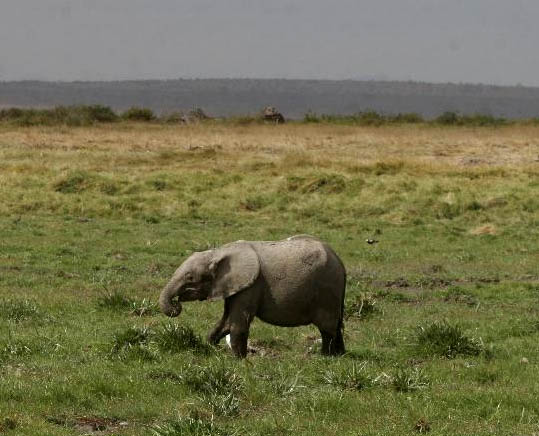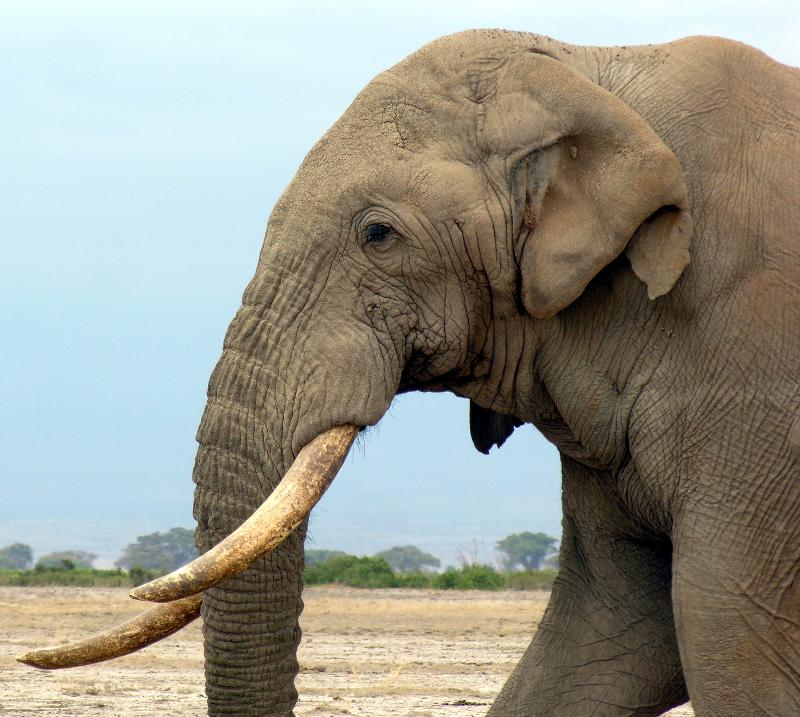|
Rescue of an Orphan
Orphaned Calf  | Norah and Soila were out on the western side of the Park on October 1, searching for elephants and carrying out censuses of the families and individual bulls. In the area that we call Pelican Lake they found a female elephant calf completely on own. They estimated that she was about one and a half years old, definitely too young to survive on her own. A calf of this age still needs milk and needs her mother and other family members to protect her.
They informed the Kenya Wildlife Service and I also phoned the Senior Warden. He gave me the go-ahead to call the David Sheldrick Wildlife Trust. I got through to them and they immediately went into action, arranging an airplane and their keepers and flying down to Amboseli.
Soila picked them up at the airstrip and they went out to
the calf.
The rescue couldn't have gone more smoothly. The Sheldrick
Trust team is very competent and very caring. It took just four men to capture
her, move her to a truck and then with the help of a few more get her on to the
airplane.
Because we do not know which family the calf came from or who her
mother was, the ATE team suggested the name "Kitirua", which is a hill in the general area where she was found. We think her mother must be dead because the
calf would never have been left alone if she was living.
Angela Sheldrick reported to us that Kitirua is doing well.
She was very feisty at first, but has finally calmed down and particularly
enjoys the company of the other orphans. To read more about the orphanage go
to the
Sheldrick Trust website.
Kitirua would have been killed by hyenas or lions that night if we hadn't found her. It is so important for us to be out in the field every day. Please help us pay for our researchers and their vehicle running costs.
|
|
Endangered
Tree Species Discovered in Amboseli National Park While undertaking a vegetation survey of Amboseli, ATE's
John Kioko, and researchers from the Kenya Wildlife Service found considerable
stands of African sandalwood (Osyris
lanceolata), a plant not previously documented to exist in the Park. The
plant has several uses that include extraction of essential oil from the bark
for the overseas manufacture of perfumes and incense. Locally the plant's bark
is used to treat diarrhea and snake bite; it is also used as a soup ingredient
and a substitute for tea.
The commercial demand for sandalwood threatens to force
the species to extinction in the wild. This overexploitation led the Kenyan government to
declare the plant protected. There is a lucrative market for sandalwood
in Europe and Asia by the cosmetic and pharmaceutical industry. This demand has
fueled local poaching of the plant. At a price of over $10 a kilogram the
incentive to harvest sandalwood illegally is strong. In the last couple of years tons of sandalwood, which is killed when harvested, have been confiscated
from poachers. Much more must be getting through to the international
market. This demand has
fueled local poaching of the plant. At a price of over $10 a kilogram the
incentive to harvest sandalwood illegally is strong. In the last couple of years tons of sandalwood, which is killed when harvested, have been confiscated
from poachers. Much more must be getting through to the international
market.
The disappearance of the plant in most
non-protected parts of Kenya makes it's presence in Amboseli National Park important to conservationists and scientists. Future research on this plant will
focus on the factors influencing its distribution in the Park, particularly the
influence of elephants and other browsers on the species.
|
|
More Bulls Die
Sheikh Zayad  | Two more magnificent bulls have died at
the hand of man in the Amboseli ecosystem. On September 18, Norah and Katito found Sheihk Zayad dead. He had been sick for
some time with a septic wound caused by a poison arrow or a spear. It was
better that he finally died; but not in any way good that he was injured in the
first place. He was estimated to have been born in 1956 which made him 54. He was one of the last of the big bulls over 50. In
fact, we think he might have been THE last because we haven't seen the other
two-Richard and Sioma-for a long time.
A younger bull, Goliath, died last week. He was 46
years old and was very distinctive looking because he was born with a deformed
ear. Goliath was found dying of infected
spear wounds. The Kenya Wildlife Service shot him and collected his tusks before
any poachers could. They were also able to get Sheik Zayad's tusks because he
died in the Kimana Sanctuary east of Amboseli.
Goliath  |
So technically neither of these cases was poaching,
but we don't know what the motivations of the attacks on them were. Whatever
the case, we are rapidly losing Amboseli's important breeding bulls. We at ATE
are doing everything we can. Of course, we can't be out there with guns trying
to stop poachers, but we are eyes and ears on the ground, and we are working
closely with the Maasai community to get them on the side of conservation. We
need your support in this work and ask that you send donations to help us.
|
Our Website Please donate through Click & Pledge
|
|
The History of the BB Family
 I first
met the BB family on October 20, 1973.
My colleague Harvey Croze begin_of_the_skype_highlighting end_of_the_skype_highlighting and I were struck by the family immediately
because it was led by a huge, tuskless female who had the biggest ears I have
ever seen on an elephant. The family was
very distinctive. Not only was there
this magnificent, big tuskless, but there was also a second tuskless female, a
one-tusked female, and a tuskless calf. It
looked like this was going to be very easy family to get know and start collecting
data on. As it turned out there was a certain amount of confusion
about this "double tuskless" family. We
managed to photograph the adult females and began to get some idea of its
composition over the next few sightings.
I saw the family two more times in 1973 and concluded that there were
eleven members. Since I kept referring to the matriarch as Big Tuskless, that
became her name and the family was designated the BBs (there was already a BA
family) although we still also referred to them as the Double Tusklesses. All the other adult females were then given
names beginning with 'B'. Bette was named after a friend from high school and
Barbara was named after my roommate in college. We named the young female
Bonnie and the young male Ben. The family appeared to consist of the following
members:
Big
Tuskless
Adult female
tuskless
her calf
2-3
years old
female calf about
7 years old
Bette Adult
female tuskless
her calf
also tuskless,
3-4 years old
Barbara Adult female
with splayed tusks
her calf 2-3
years old
Belinda Young female
about 13 years old
her calf less
than 1 year old
Bonnie about 10
years old
Ben about 10
years old
To find out why
there was a confusion about the BB family, read the rest of the history on the
ATE website: Full History of the BB Family.
|